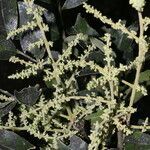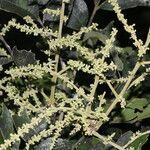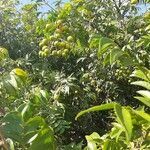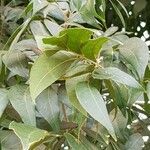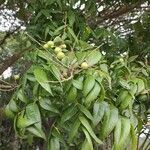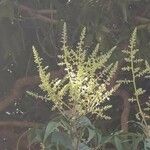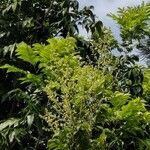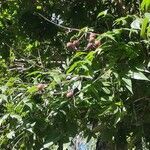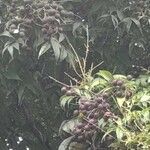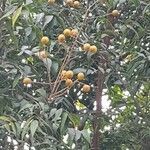Tree to 5 m tall. Stems glabrous or nearly so, terete, striate, lenticellate. Leaves paripinnate; petiole plus rachis 10-20 cm long, nearly terete, striate, sometimes broadly winged; leaflets 2-6 pairs, alternate or opposite, chartaceous, glabrous or abaxially puberulent with minute papillae, lanceolate, oblong-elliptic, ovate-lanceolate, or falcate, 5-13 × 2-5 cm, the base asymmetrical, one side acute the other obtuse, the apex acuminate to long-acuminate, the margins entire; venation prominent on abaxial surface; tertiary veins reticulate. Thyrses axillary or distal, 9-20 cm long, paniculate; axes tomentulose, slightly angled. Flowers in compound, sessile dichasia; pedicels ca. 1 mm long, tomentose. Calyx white, glabrous, sepals concave, rounded at apex ciliate on margins, outer sepals 1.2-1.5 mm long, inner sepals 1.7-2.2 mm long; petals white, rhombate, clawed, ca. 1.2 mm long, ciliate on margins, without appendage; disc cup-shaped, 8-lobed, ca. 1.2 mm tall, glabrous; stamens 8, the filaments of unequal length, tomentose at base; ovary ovoid, glabrous, stigma stout, unbranched, papillate at narrowed apex. Fruits green to yellowish, 1-to 2-coccate, with 1 or 2 rudimentary cocci, glabrous, the cocci globose, 1.5-2 cm long. Seeds nearly globose, exarillate, dull black, with minute linear hilum and scattered wooly hairs at base.
Trees 3-17(-23) m tall, to 18 cm d.b.h.; stems sulcate, glabrous to puberu-lent. Leaves pinnate, 10-30(-57) cm long; leaflets 5-10, narrowly lanceolate to oblong, unequal, obtuse to long-acuminate at the apex, acute or obtuse to attenuate at the base, entire, membranous to somewhat coriaceous, 5-13(-20) cm long, 3-5(-7.3) cm wide, glabrous or subglabrous; rachis sulcate, marginally ribbed or winged; petioles winged or wingless. Panicle terminal, 15-25 cm long, the branches and pedicels densely puberulent to tomentose; pedicels 0.5-1.5 mm long, articulate above the middle. Flowers white; sepals rotund or elliptic, puberu-lent, ciliolate, ca. 3 mm long; petals ca. 1.5 mm long, ciliolate, glabrous without, villous at base within; disc fleshy, spreading, glabrous; stamens exserted, to ca. 3 mm long, the filaments filiform, villous to about midway; ovary ovate, 3-lobed, glabrous. Fruit of 1-3 cocci; cocci brown to yellow, globose, glabrous, ca. 1.5 cm diam., shiny, often lenticellate at maturity, the surface smooth; seeds globose, 1.2 cm diam., set at the base of the carpel in a cottony mat of pubescence. Sapindus saponaria is distinguished from other Sapindaceae in Panama by be-ing arborescent, pinnately leaved, and having indehiscent 2-or 3-lobed fruits.
Trees, deciduous, to 20 m tall. Bark grayish brown or blackish brown; young branches green, glabrous. Leaves with petiole 25-45 cm or longer, axis slightly flat, grooved adaxially, glabrous or pilosulose; leaflets 5-8 pairs, usually subopposite; petiolule ca. 5 mm; blades adaxially shiny, narrowly elliptic-lanceolate or slightly falcate, 7-15 × 2-5 cm, thinly papery, abaxially glabrous or pilosulose, lateral veins 15-17 pairs, nearly parallel, dense, slender, base cuneate, slightly asymmetrical, apex acute or shortly acuminate. Inflorescences terminal, conical. Flowers actinomorphic, small. Pedicels very short. Sepals ovate or oblong-ovate, larger ones ca. 2 mm, abaxially pilose at base. Petals 5, lanceolate, ca. 2.5 mm, abaxially villous at base or subglabrous, long clawed; scales 2, earlike, at base adaxially. Disk acetabuliform, glabrous. Stamens 8, exserted; filaments ca. 3.5 mm, densely villous below middle. Ovary glabrous. Fertile schizocarps orange, black when dry, subglobose, 2-2.5 cm in diam. Fl. spring, fr. summer-autumn.
A tree. It grows 6-16 m high. The trunk is 60 cm across. The bark is grey, cracked and flaky. The leaves have leaflets along the stalk. There are 5-17 narrow leaflets. They are 5-18 cm long. The flowers are white and 4 mm across. The fruit is a one seeded berry. It is 1-1.5 cm across. It has a yellow pulp that lets light through. The fruit remain on the tree after ripening. The seeds are brown.
